Human Resources Management: A Report on Gender Pay Gap at the BBC
VerifiedAdded on 2023/01/17
|11
|2653
|41
Report
AI Summary
This report examines the gender pay gap within the BBC, identifying causes such as discrimination in hiring and pay decisions, bonus disparities, industry segregation, and challenges faced by women balancing family and career. It discusses the historical context of women's participation in the labor force, including the impact of World War I and subsequent changes in employment opportunities. The report also references the Equality Act and other governmental efforts to address pay disparities. Furthermore, it highlights the types of jobs commonly held by women, often lower-paying roles that contribute to the overall gender pay gap. The report concludes by emphasizing the importance of equal pay for equal work, regardless of gender, and suggests recommendations for reducing the gender pay gap within organizations like the BBC. Desklib provides resources like this report to aid students in their studies.
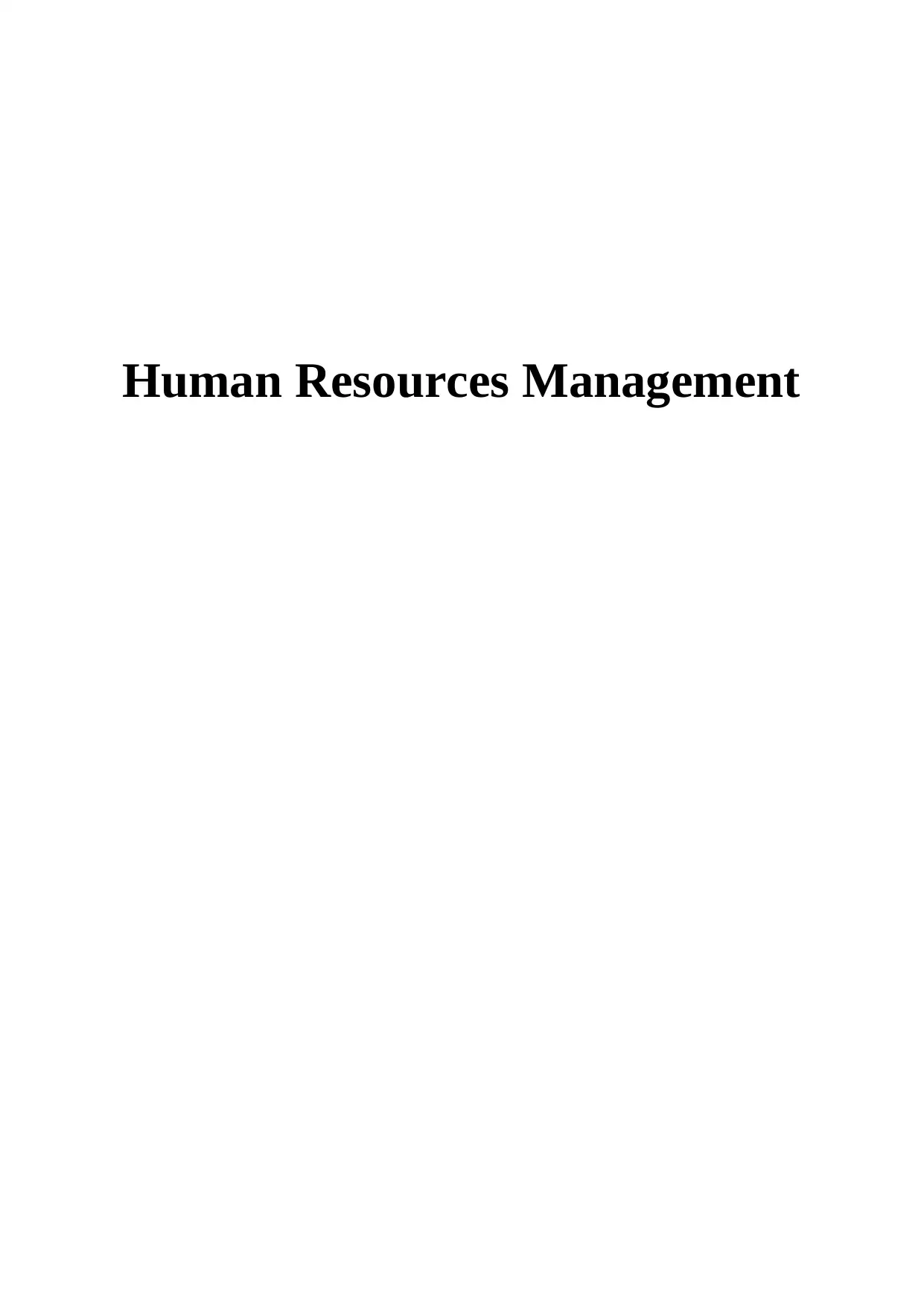
Human Resources Management
Paraphrase This Document
Need a fresh take? Get an instant paraphrase of this document with our AI Paraphraser

Abstract
The report discuss gender pay gap in BBC and the reasons that causes gender
pay gap. This also includes various factors that restrict women employees from
occupying higher pay positions and that contribute to pay gap on the basis of
gender. This report also includes various steps that government has taken in
order to reduce gender pay gap.
The report discuss gender pay gap in BBC and the reasons that causes gender
pay gap. This also includes various factors that restrict women employees from
occupying higher pay positions and that contribute to pay gap on the basis of
gender. This report also includes various steps that government has taken in
order to reduce gender pay gap.
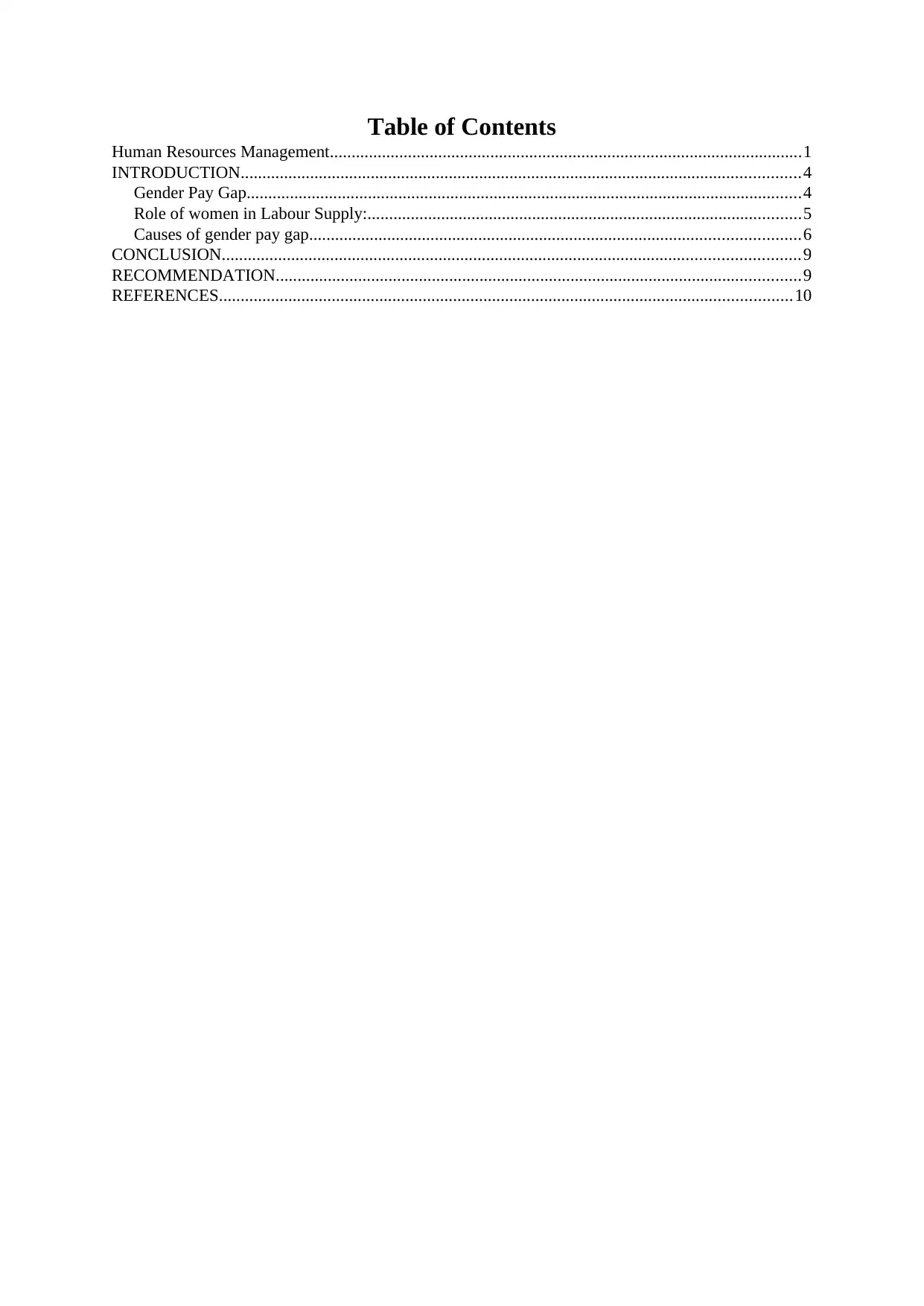
Table of Contents
Human Resources Management.............................................................................................................1
INTRODUCTION.................................................................................................................................4
Gender Pay Gap................................................................................................................................4
Role of women in Labour Supply:....................................................................................................5
Causes of gender pay gap.................................................................................................................6
CONCLUSION.....................................................................................................................................9
RECOMMENDATION.........................................................................................................................9
REFERENCES....................................................................................................................................10
Human Resources Management.............................................................................................................1
INTRODUCTION.................................................................................................................................4
Gender Pay Gap................................................................................................................................4
Role of women in Labour Supply:....................................................................................................5
Causes of gender pay gap.................................................................................................................6
CONCLUSION.....................................................................................................................................9
RECOMMENDATION.........................................................................................................................9
REFERENCES....................................................................................................................................10
⊘ This is a preview!⊘
Do you want full access?
Subscribe today to unlock all pages.

Trusted by 1+ million students worldwide
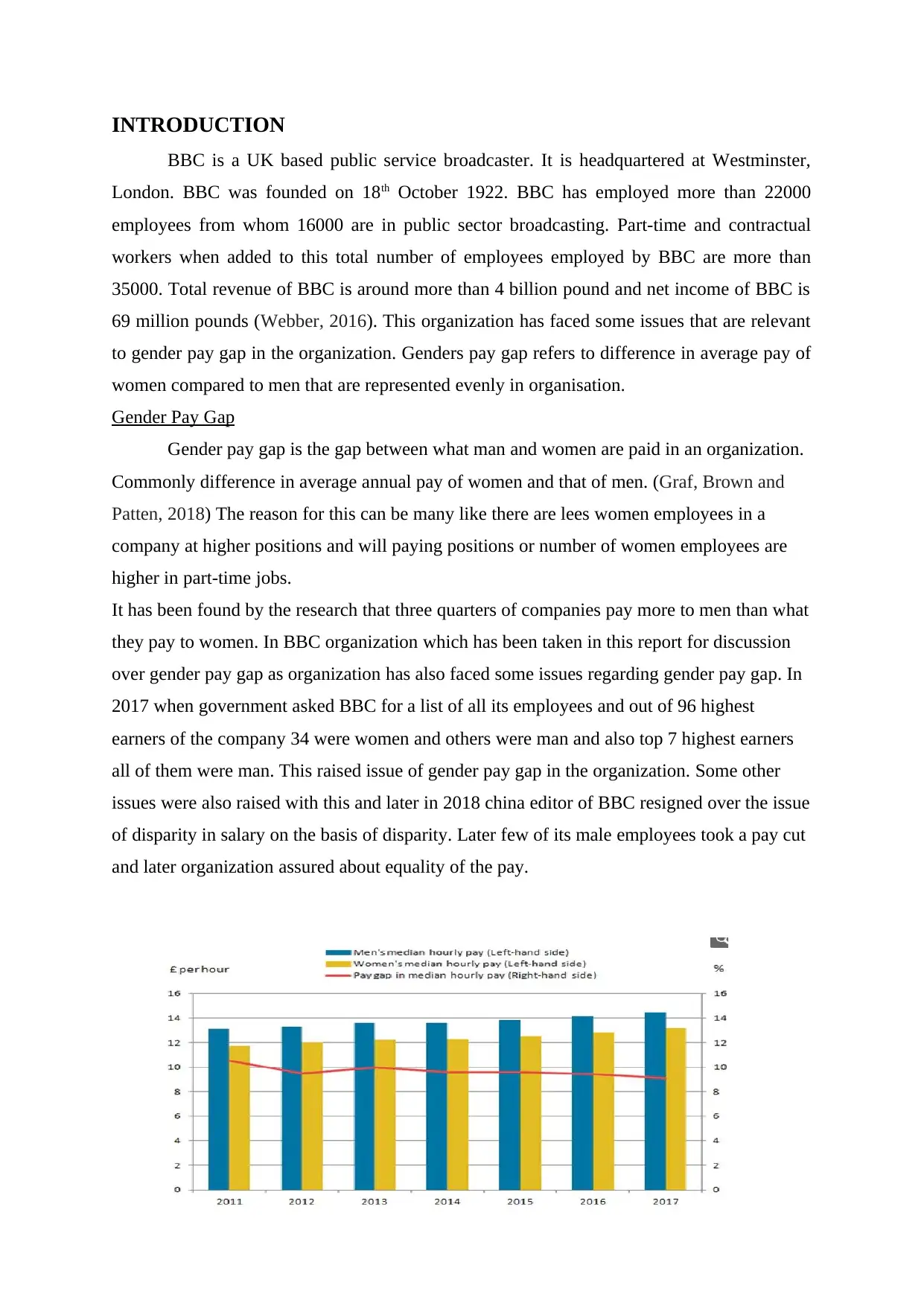
INTRODUCTION
BBC is a UK based public service broadcaster. It is headquartered at Westminster,
London. BBC was founded on 18th October 1922. BBC has employed more than 22000
employees from whom 16000 are in public sector broadcasting. Part-time and contractual
workers when added to this total number of employees employed by BBC are more than
35000. Total revenue of BBC is around more than 4 billion pound and net income of BBC is
69 million pounds (Webber, 2016). This organization has faced some issues that are relevant
to gender pay gap in the organization. Genders pay gap refers to difference in average pay of
women compared to men that are represented evenly in organisation.
Gender Pay Gap
Gender pay gap is the gap between what man and women are paid in an organization.
Commonly difference in average annual pay of women and that of men. (Graf, Brown and
Patten, 2018) The reason for this can be many like there are lees women employees in a
company at higher positions and will paying positions or number of women employees are
higher in part-time jobs.
It has been found by the research that three quarters of companies pay more to men than what
they pay to women. In BBC organization which has been taken in this report for discussion
over gender pay gap as organization has also faced some issues regarding gender pay gap. In
2017 when government asked BBC for a list of all its employees and out of 96 highest
earners of the company 34 were women and others were man and also top 7 highest earners
all of them were man. This raised issue of gender pay gap in the organization. Some other
issues were also raised with this and later in 2018 china editor of BBC resigned over the issue
of disparity in salary on the basis of disparity. Later few of its male employees took a pay cut
and later organization assured about equality of the pay.
BBC is a UK based public service broadcaster. It is headquartered at Westminster,
London. BBC was founded on 18th October 1922. BBC has employed more than 22000
employees from whom 16000 are in public sector broadcasting. Part-time and contractual
workers when added to this total number of employees employed by BBC are more than
35000. Total revenue of BBC is around more than 4 billion pound and net income of BBC is
69 million pounds (Webber, 2016). This organization has faced some issues that are relevant
to gender pay gap in the organization. Genders pay gap refers to difference in average pay of
women compared to men that are represented evenly in organisation.
Gender Pay Gap
Gender pay gap is the gap between what man and women are paid in an organization.
Commonly difference in average annual pay of women and that of men. (Graf, Brown and
Patten, 2018) The reason for this can be many like there are lees women employees in a
company at higher positions and will paying positions or number of women employees are
higher in part-time jobs.
It has been found by the research that three quarters of companies pay more to men than what
they pay to women. In BBC organization which has been taken in this report for discussion
over gender pay gap as organization has also faced some issues regarding gender pay gap. In
2017 when government asked BBC for a list of all its employees and out of 96 highest
earners of the company 34 were women and others were man and also top 7 highest earners
all of them were man. This raised issue of gender pay gap in the organization. Some other
issues were also raised with this and later in 2018 china editor of BBC resigned over the issue
of disparity in salary on the basis of disparity. Later few of its male employees took a pay cut
and later organization assured about equality of the pay.
Paraphrase This Document
Need a fresh take? Get an instant paraphrase of this document with our AI Paraphraser
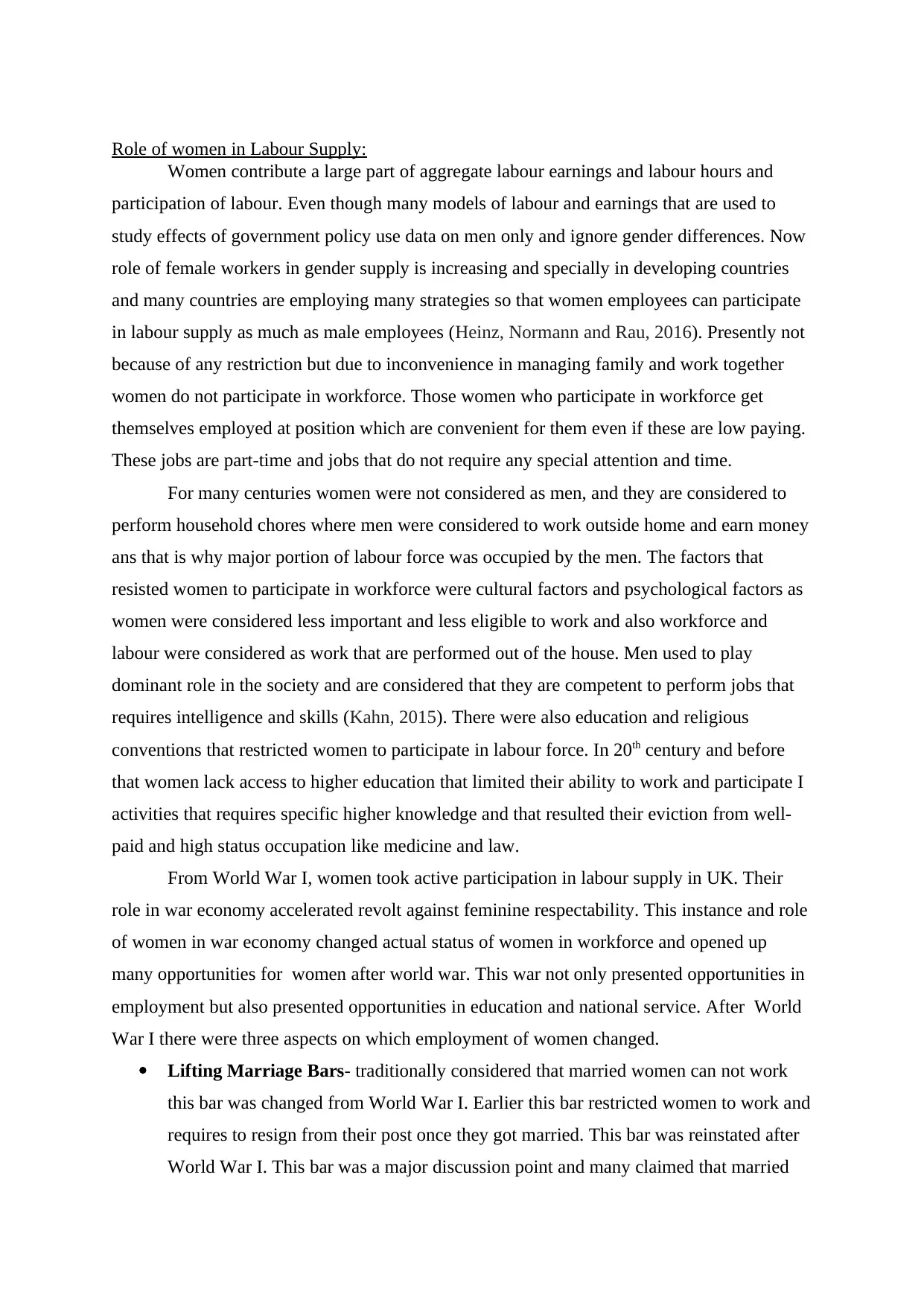
Role of women in Labour Supply:
Women contribute a large part of aggregate labour earnings and labour hours and
participation of labour. Even though many models of labour and earnings that are used to
study effects of government policy use data on men only and ignore gender differences. Now
role of female workers in gender supply is increasing and specially in developing countries
and many countries are employing many strategies so that women employees can participate
in labour supply as much as male employees (Heinz, Normann and Rau, 2016). Presently not
because of any restriction but due to inconvenience in managing family and work together
women do not participate in workforce. Those women who participate in workforce get
themselves employed at position which are convenient for them even if these are low paying.
These jobs are part-time and jobs that do not require any special attention and time.
For many centuries women were not considered as men, and they are considered to
perform household chores where men were considered to work outside home and earn money
ans that is why major portion of labour force was occupied by the men. The factors that
resisted women to participate in workforce were cultural factors and psychological factors as
women were considered less important and less eligible to work and also workforce and
labour were considered as work that are performed out of the house. Men used to play
dominant role in the society and are considered that they are competent to perform jobs that
requires intelligence and skills (Kahn, 2015). There were also education and religious
conventions that restricted women to participate in labour force. In 20th century and before
that women lack access to higher education that limited their ability to work and participate I
activities that requires specific higher knowledge and that resulted their eviction from well-
paid and high status occupation like medicine and law.
From World War I, women took active participation in labour supply in UK. Their
role in war economy accelerated revolt against feminine respectability. This instance and role
of women in war economy changed actual status of women in workforce and opened up
many opportunities for women after world war. This war not only presented opportunities in
employment but also presented opportunities in education and national service. After World
War I there were three aspects on which employment of women changed.
Lifting Marriage Bars- traditionally considered that married women can not work
this bar was changed from World War I. Earlier this bar restricted women to work and
requires to resign from their post once they got married. This bar was reinstated after
World War I. This bar was a major discussion point and many claimed that married
Women contribute a large part of aggregate labour earnings and labour hours and
participation of labour. Even though many models of labour and earnings that are used to
study effects of government policy use data on men only and ignore gender differences. Now
role of female workers in gender supply is increasing and specially in developing countries
and many countries are employing many strategies so that women employees can participate
in labour supply as much as male employees (Heinz, Normann and Rau, 2016). Presently not
because of any restriction but due to inconvenience in managing family and work together
women do not participate in workforce. Those women who participate in workforce get
themselves employed at position which are convenient for them even if these are low paying.
These jobs are part-time and jobs that do not require any special attention and time.
For many centuries women were not considered as men, and they are considered to
perform household chores where men were considered to work outside home and earn money
ans that is why major portion of labour force was occupied by the men. The factors that
resisted women to participate in workforce were cultural factors and psychological factors as
women were considered less important and less eligible to work and also workforce and
labour were considered as work that are performed out of the house. Men used to play
dominant role in the society and are considered that they are competent to perform jobs that
requires intelligence and skills (Kahn, 2015). There were also education and religious
conventions that restricted women to participate in labour force. In 20th century and before
that women lack access to higher education that limited their ability to work and participate I
activities that requires specific higher knowledge and that resulted their eviction from well-
paid and high status occupation like medicine and law.
From World War I, women took active participation in labour supply in UK. Their
role in war economy accelerated revolt against feminine respectability. This instance and role
of women in war economy changed actual status of women in workforce and opened up
many opportunities for women after world war. This war not only presented opportunities in
employment but also presented opportunities in education and national service. After World
War I there were three aspects on which employment of women changed.
Lifting Marriage Bars- traditionally considered that married women can not work
this bar was changed from World War I. Earlier this bar restricted women to work and
requires to resign from their post once they got married. This bar was reinstated after
World War I. This bar was a major discussion point and many claimed that married
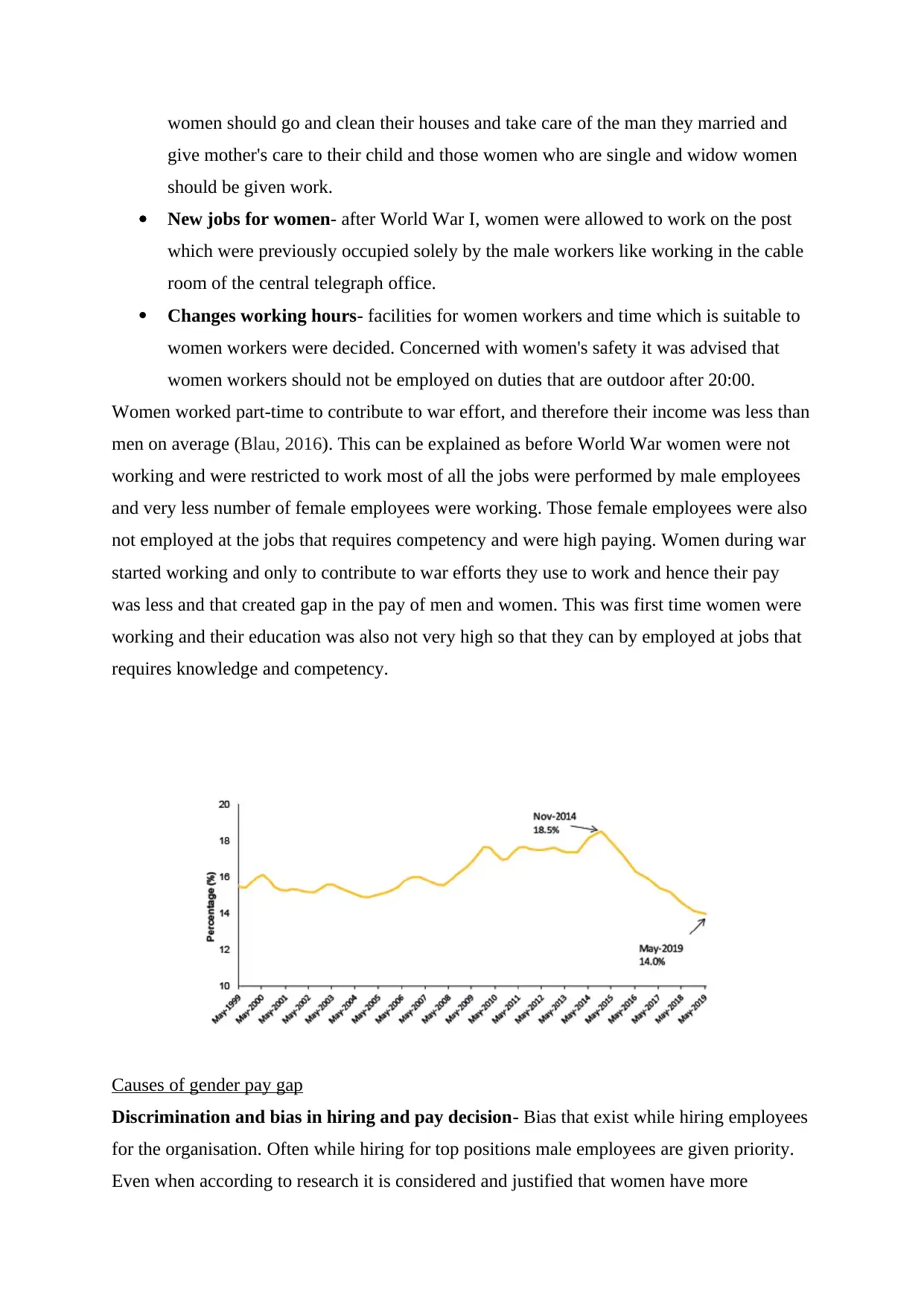
women should go and clean their houses and take care of the man they married and
give mother's care to their child and those women who are single and widow women
should be given work.
New jobs for women- after World War I, women were allowed to work on the post
which were previously occupied solely by the male workers like working in the cable
room of the central telegraph office.
Changes working hours- facilities for women workers and time which is suitable to
women workers were decided. Concerned with women's safety it was advised that
women workers should not be employed on duties that are outdoor after 20:00.
Women worked part-time to contribute to war effort, and therefore their income was less than
men on average (Blau, 2016). This can be explained as before World War women were not
working and were restricted to work most of all the jobs were performed by male employees
and very less number of female employees were working. Those female employees were also
not employed at the jobs that requires competency and were high paying. Women during war
started working and only to contribute to war efforts they use to work and hence their pay
was less and that created gap in the pay of men and women. This was first time women were
working and their education was also not very high so that they can by employed at jobs that
requires knowledge and competency.
Causes of gender pay gap
Discrimination and bias in hiring and pay decision- Bias that exist while hiring employees
for the organisation. Often while hiring for top positions male employees are given priority.
Even when according to research it is considered and justified that women have more
give mother's care to their child and those women who are single and widow women
should be given work.
New jobs for women- after World War I, women were allowed to work on the post
which were previously occupied solely by the male workers like working in the cable
room of the central telegraph office.
Changes working hours- facilities for women workers and time which is suitable to
women workers were decided. Concerned with women's safety it was advised that
women workers should not be employed on duties that are outdoor after 20:00.
Women worked part-time to contribute to war effort, and therefore their income was less than
men on average (Blau, 2016). This can be explained as before World War women were not
working and were restricted to work most of all the jobs were performed by male employees
and very less number of female employees were working. Those female employees were also
not employed at the jobs that requires competency and were high paying. Women during war
started working and only to contribute to war efforts they use to work and hence their pay
was less and that created gap in the pay of men and women. This was first time women were
working and their education was also not very high so that they can by employed at jobs that
requires knowledge and competency.
Causes of gender pay gap
Discrimination and bias in hiring and pay decision- Bias that exist while hiring employees
for the organisation. Often while hiring for top positions male employees are given priority.
Even when according to research it is considered and justified that women have more
⊘ This is a preview!⊘
Do you want full access?
Subscribe today to unlock all pages.

Trusted by 1+ million students worldwide
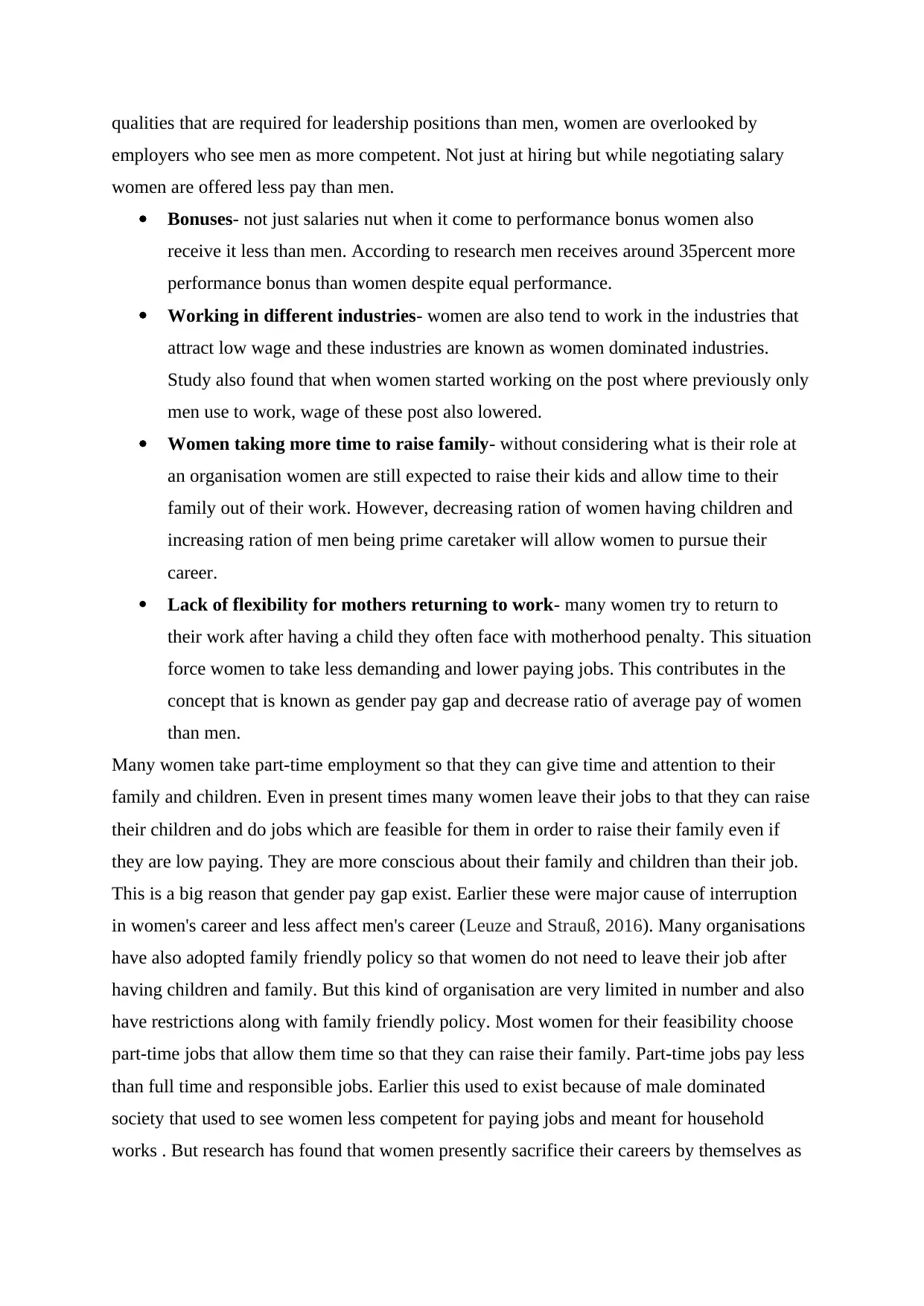
qualities that are required for leadership positions than men, women are overlooked by
employers who see men as more competent. Not just at hiring but while negotiating salary
women are offered less pay than men.
Bonuses- not just salaries nut when it come to performance bonus women also
receive it less than men. According to research men receives around 35percent more
performance bonus than women despite equal performance.
Working in different industries- women are also tend to work in the industries that
attract low wage and these industries are known as women dominated industries.
Study also found that when women started working on the post where previously only
men use to work, wage of these post also lowered.
Women taking more time to raise family- without considering what is their role at
an organisation women are still expected to raise their kids and allow time to their
family out of their work. However, decreasing ration of women having children and
increasing ration of men being prime caretaker will allow women to pursue their
career.
Lack of flexibility for mothers returning to work- many women try to return to
their work after having a child they often face with motherhood penalty. This situation
force women to take less demanding and lower paying jobs. This contributes in the
concept that is known as gender pay gap and decrease ratio of average pay of women
than men.
Many women take part-time employment so that they can give time and attention to their
family and children. Even in present times many women leave their jobs to that they can raise
their children and do jobs which are feasible for them in order to raise their family even if
they are low paying. They are more conscious about their family and children than their job.
This is a big reason that gender pay gap exist. Earlier these were major cause of interruption
in women's career and less affect men's career (Leuze and Strauß, 2016). Many organisations
have also adopted family friendly policy so that women do not need to leave their job after
having children and family. But this kind of organisation are very limited in number and also
have restrictions along with family friendly policy. Most women for their feasibility choose
part-time jobs that allow them time so that they can raise their family. Part-time jobs pay less
than full time and responsible jobs. Earlier this used to exist because of male dominated
society that used to see women less competent for paying jobs and meant for household
works . But research has found that women presently sacrifice their careers by themselves as
employers who see men as more competent. Not just at hiring but while negotiating salary
women are offered less pay than men.
Bonuses- not just salaries nut when it come to performance bonus women also
receive it less than men. According to research men receives around 35percent more
performance bonus than women despite equal performance.
Working in different industries- women are also tend to work in the industries that
attract low wage and these industries are known as women dominated industries.
Study also found that when women started working on the post where previously only
men use to work, wage of these post also lowered.
Women taking more time to raise family- without considering what is their role at
an organisation women are still expected to raise their kids and allow time to their
family out of their work. However, decreasing ration of women having children and
increasing ration of men being prime caretaker will allow women to pursue their
career.
Lack of flexibility for mothers returning to work- many women try to return to
their work after having a child they often face with motherhood penalty. This situation
force women to take less demanding and lower paying jobs. This contributes in the
concept that is known as gender pay gap and decrease ratio of average pay of women
than men.
Many women take part-time employment so that they can give time and attention to their
family and children. Even in present times many women leave their jobs to that they can raise
their children and do jobs which are feasible for them in order to raise their family even if
they are low paying. They are more conscious about their family and children than their job.
This is a big reason that gender pay gap exist. Earlier these were major cause of interruption
in women's career and less affect men's career (Leuze and Strauß, 2016). Many organisations
have also adopted family friendly policy so that women do not need to leave their job after
having children and family. But this kind of organisation are very limited in number and also
have restrictions along with family friendly policy. Most women for their feasibility choose
part-time jobs that allow them time so that they can raise their family. Part-time jobs pay less
than full time and responsible jobs. Earlier this used to exist because of male dominated
society that used to see women less competent for paying jobs and meant for household
works . But research has found that women presently sacrifice their careers by themselves as
Paraphrase This Document
Need a fresh take? Get an instant paraphrase of this document with our AI Paraphraser
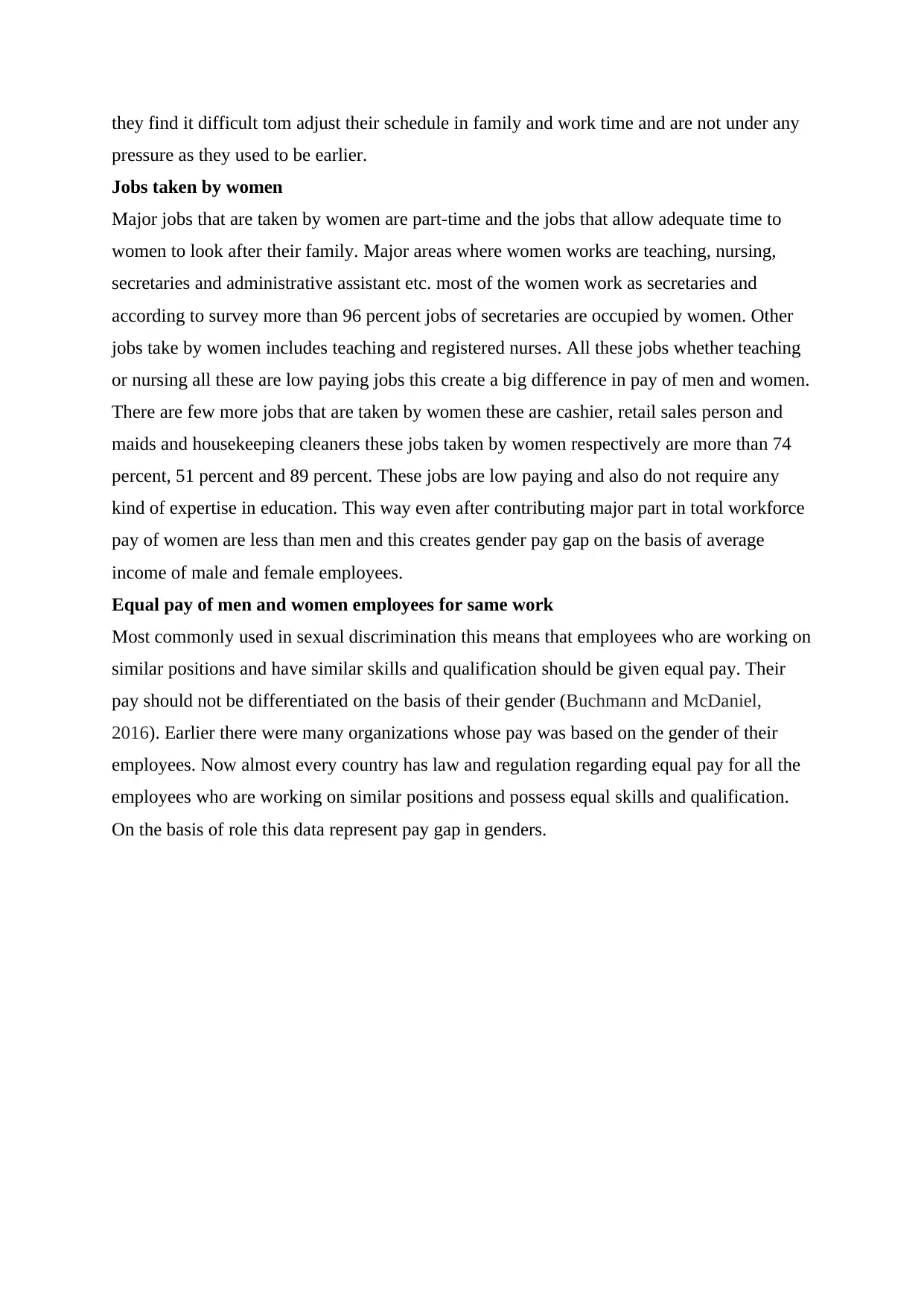
they find it difficult tom adjust their schedule in family and work time and are not under any
pressure as they used to be earlier.
Jobs taken by women
Major jobs that are taken by women are part-time and the jobs that allow adequate time to
women to look after their family. Major areas where women works are teaching, nursing,
secretaries and administrative assistant etc. most of the women work as secretaries and
according to survey more than 96 percent jobs of secretaries are occupied by women. Other
jobs take by women includes teaching and registered nurses. All these jobs whether teaching
or nursing all these are low paying jobs this create a big difference in pay of men and women.
There are few more jobs that are taken by women these are cashier, retail sales person and
maids and housekeeping cleaners these jobs taken by women respectively are more than 74
percent, 51 percent and 89 percent. These jobs are low paying and also do not require any
kind of expertise in education. This way even after contributing major part in total workforce
pay of women are less than men and this creates gender pay gap on the basis of average
income of male and female employees.
Equal pay of men and women employees for same work
Most commonly used in sexual discrimination this means that employees who are working on
similar positions and have similar skills and qualification should be given equal pay. Their
pay should not be differentiated on the basis of their gender (Buchmann and McDaniel,
2016). Earlier there were many organizations whose pay was based on the gender of their
employees. Now almost every country has law and regulation regarding equal pay for all the
employees who are working on similar positions and possess equal skills and qualification.
On the basis of role this data represent pay gap in genders.
pressure as they used to be earlier.
Jobs taken by women
Major jobs that are taken by women are part-time and the jobs that allow adequate time to
women to look after their family. Major areas where women works are teaching, nursing,
secretaries and administrative assistant etc. most of the women work as secretaries and
according to survey more than 96 percent jobs of secretaries are occupied by women. Other
jobs take by women includes teaching and registered nurses. All these jobs whether teaching
or nursing all these are low paying jobs this create a big difference in pay of men and women.
There are few more jobs that are taken by women these are cashier, retail sales person and
maids and housekeeping cleaners these jobs taken by women respectively are more than 74
percent, 51 percent and 89 percent. These jobs are low paying and also do not require any
kind of expertise in education. This way even after contributing major part in total workforce
pay of women are less than men and this creates gender pay gap on the basis of average
income of male and female employees.
Equal pay of men and women employees for same work
Most commonly used in sexual discrimination this means that employees who are working on
similar positions and have similar skills and qualification should be given equal pay. Their
pay should not be differentiated on the basis of their gender (Buchmann and McDaniel,
2016). Earlier there were many organizations whose pay was based on the gender of their
employees. Now almost every country has law and regulation regarding equal pay for all the
employees who are working on similar positions and possess equal skills and qualification.
On the basis of role this data represent pay gap in genders.
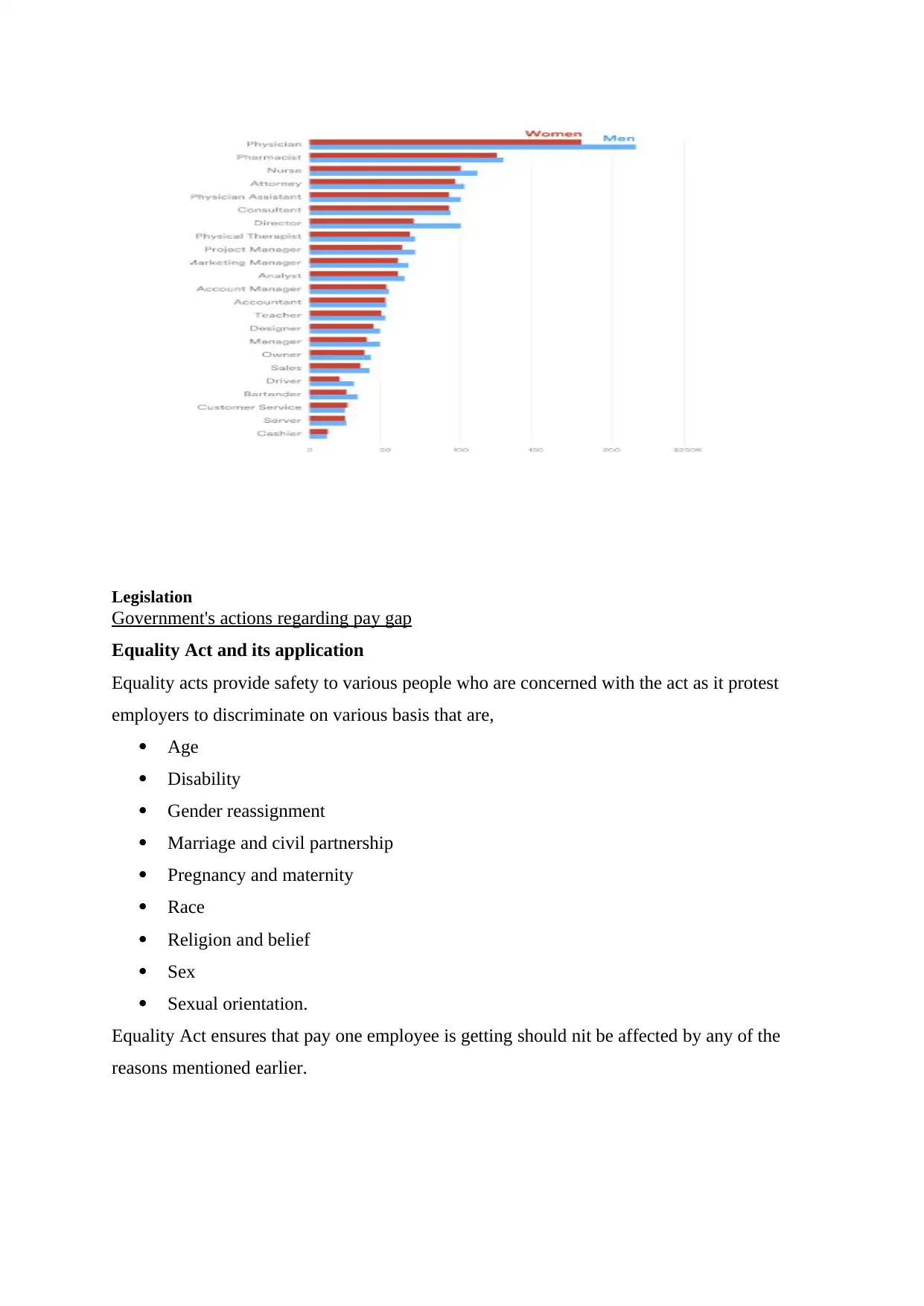
Legislation
Government's actions regarding pay gap
Equality Act and its application
Equality acts provide safety to various people who are concerned with the act as it protest
employers to discriminate on various basis that are,
Age
Disability
Gender reassignment
Marriage and civil partnership
Pregnancy and maternity
Race
Religion and belief
Sex
Sexual orientation.
Equality Act ensures that pay one employee is getting should nit be affected by any of the
reasons mentioned earlier.
Government's actions regarding pay gap
Equality Act and its application
Equality acts provide safety to various people who are concerned with the act as it protest
employers to discriminate on various basis that are,
Age
Disability
Gender reassignment
Marriage and civil partnership
Pregnancy and maternity
Race
Religion and belief
Sex
Sexual orientation.
Equality Act ensures that pay one employee is getting should nit be affected by any of the
reasons mentioned earlier.
⊘ This is a preview!⊘
Do you want full access?
Subscribe today to unlock all pages.

Trusted by 1+ million students worldwide
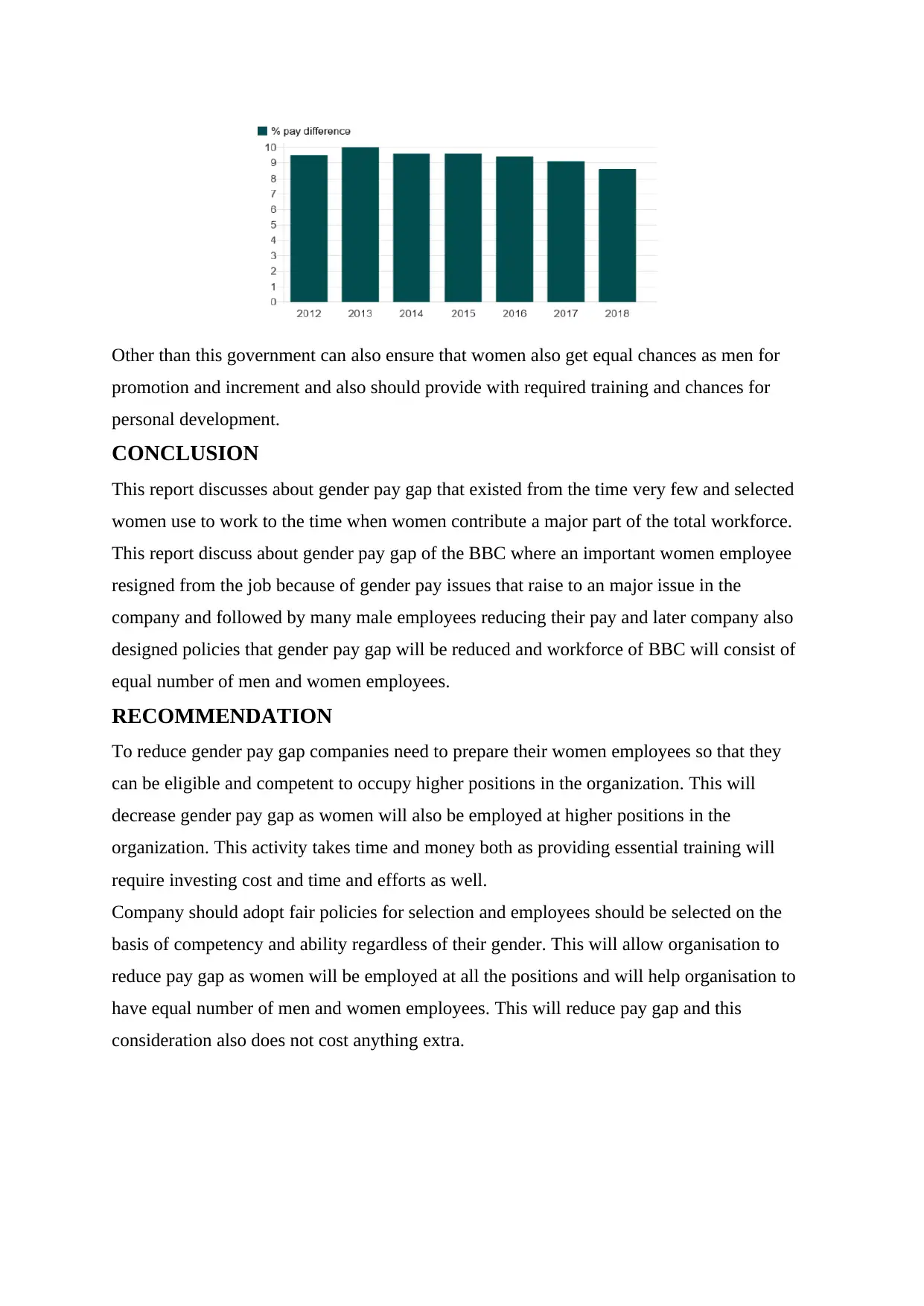
Other than this government can also ensure that women also get equal chances as men for
promotion and increment and also should provide with required training and chances for
personal development.
CONCLUSION
This report discusses about gender pay gap that existed from the time very few and selected
women use to work to the time when women contribute a major part of the total workforce.
This report discuss about gender pay gap of the BBC where an important women employee
resigned from the job because of gender pay issues that raise to an major issue in the
company and followed by many male employees reducing their pay and later company also
designed policies that gender pay gap will be reduced and workforce of BBC will consist of
equal number of men and women employees.
RECOMMENDATION
To reduce gender pay gap companies need to prepare their women employees so that they
can be eligible and competent to occupy higher positions in the organization. This will
decrease gender pay gap as women will also be employed at higher positions in the
organization. This activity takes time and money both as providing essential training will
require investing cost and time and efforts as well.
Company should adopt fair policies for selection and employees should be selected on the
basis of competency and ability regardless of their gender. This will allow organisation to
reduce pay gap as women will be employed at all the positions and will help organisation to
have equal number of men and women employees. This will reduce pay gap and this
consideration also does not cost anything extra.
promotion and increment and also should provide with required training and chances for
personal development.
CONCLUSION
This report discusses about gender pay gap that existed from the time very few and selected
women use to work to the time when women contribute a major part of the total workforce.
This report discuss about gender pay gap of the BBC where an important women employee
resigned from the job because of gender pay issues that raise to an major issue in the
company and followed by many male employees reducing their pay and later company also
designed policies that gender pay gap will be reduced and workforce of BBC will consist of
equal number of men and women employees.
RECOMMENDATION
To reduce gender pay gap companies need to prepare their women employees so that they
can be eligible and competent to occupy higher positions in the organization. This will
decrease gender pay gap as women will also be employed at higher positions in the
organization. This activity takes time and money both as providing essential training will
require investing cost and time and efforts as well.
Company should adopt fair policies for selection and employees should be selected on the
basis of competency and ability regardless of their gender. This will allow organisation to
reduce pay gap as women will be employed at all the positions and will help organisation to
have equal number of men and women employees. This will reduce pay gap and this
consideration also does not cost anything extra.
Paraphrase This Document
Need a fresh take? Get an instant paraphrase of this document with our AI Paraphraser
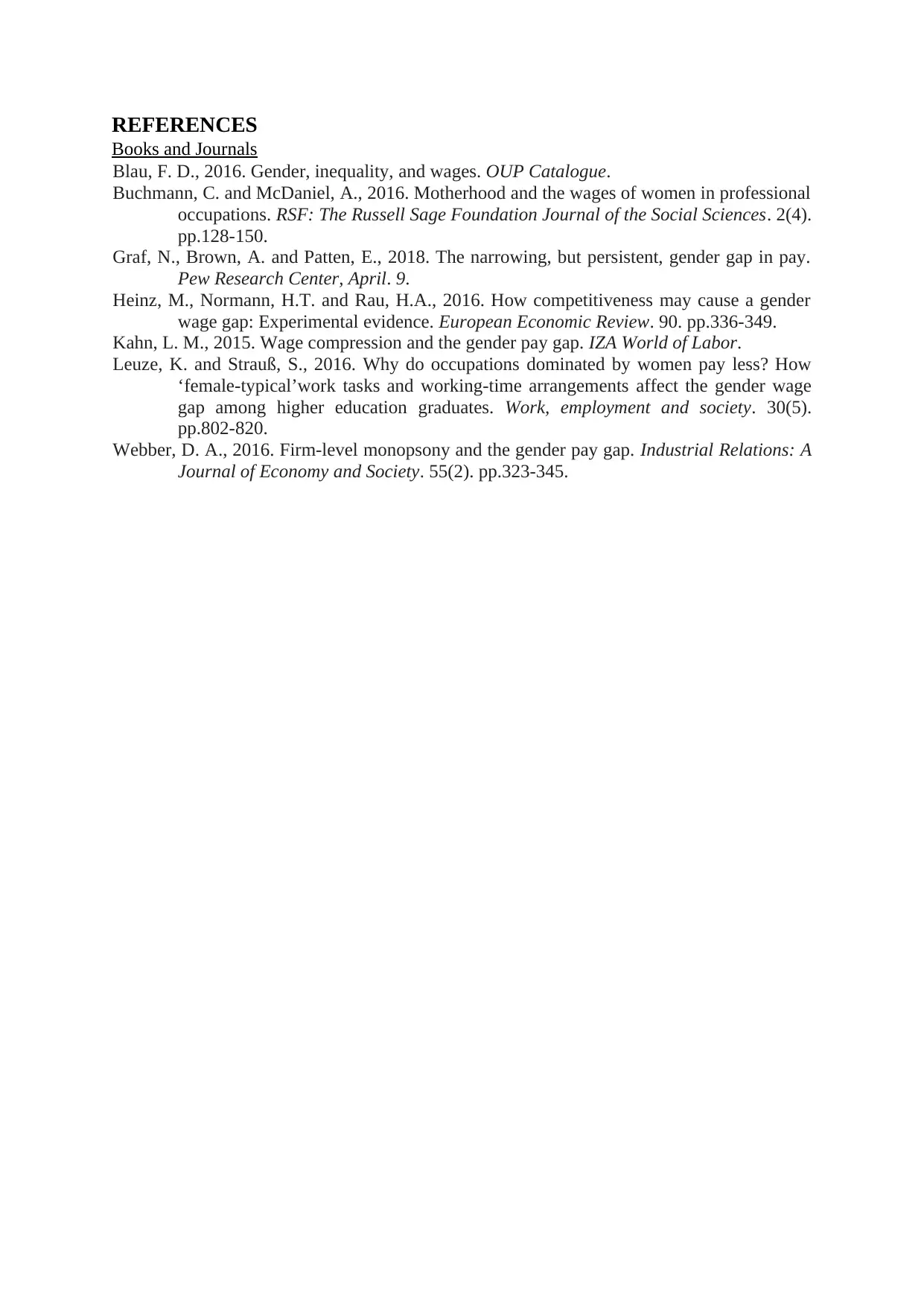
REFERENCES
Books and Journals
Blau, F. D., 2016. Gender, inequality, and wages. OUP Catalogue.
Buchmann, C. and McDaniel, A., 2016. Motherhood and the wages of women in professional
occupations. RSF: The Russell Sage Foundation Journal of the Social Sciences. 2(4).
pp.128-150.
Graf, N., Brown, A. and Patten, E., 2018. The narrowing, but persistent, gender gap in pay.
Pew Research Center, April. 9.
Heinz, M., Normann, H.T. and Rau, H.A., 2016. How competitiveness may cause a gender
wage gap: Experimental evidence. European Economic Review. 90. pp.336-349.
Kahn, L. M., 2015. Wage compression and the gender pay gap. IZA World of Labor.
Leuze, K. and Strauß, S., 2016. Why do occupations dominated by women pay less? How
‘female-typical’work tasks and working-time arrangements affect the gender wage
gap among higher education graduates. Work, employment and society. 30(5).
pp.802-820.
Webber, D. A., 2016. Firm‐level monopsony and the gender pay gap. Industrial Relations: A
Journal of Economy and Society. 55(2). pp.323-345.
Books and Journals
Blau, F. D., 2016. Gender, inequality, and wages. OUP Catalogue.
Buchmann, C. and McDaniel, A., 2016. Motherhood and the wages of women in professional
occupations. RSF: The Russell Sage Foundation Journal of the Social Sciences. 2(4).
pp.128-150.
Graf, N., Brown, A. and Patten, E., 2018. The narrowing, but persistent, gender gap in pay.
Pew Research Center, April. 9.
Heinz, M., Normann, H.T. and Rau, H.A., 2016. How competitiveness may cause a gender
wage gap: Experimental evidence. European Economic Review. 90. pp.336-349.
Kahn, L. M., 2015. Wage compression and the gender pay gap. IZA World of Labor.
Leuze, K. and Strauß, S., 2016. Why do occupations dominated by women pay less? How
‘female-typical’work tasks and working-time arrangements affect the gender wage
gap among higher education graduates. Work, employment and society. 30(5).
pp.802-820.
Webber, D. A., 2016. Firm‐level monopsony and the gender pay gap. Industrial Relations: A
Journal of Economy and Society. 55(2). pp.323-345.
1 out of 11
Related Documents
Your All-in-One AI-Powered Toolkit for Academic Success.
+13062052269
info@desklib.com
Available 24*7 on WhatsApp / Email
![[object Object]](/_next/static/media/star-bottom.7253800d.svg)
Unlock your academic potential
Copyright © 2020–2025 A2Z Services. All Rights Reserved. Developed and managed by ZUCOL.





